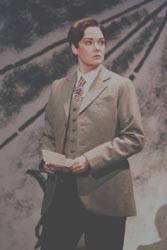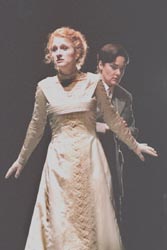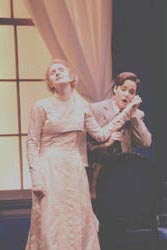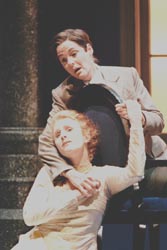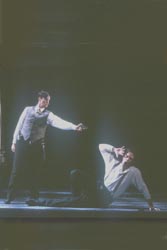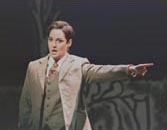 Scenes from LA Opera’s new 1999 production of Vincenzo Bellini’s I Capuleti e i Montecchi (The Capulets and the Montagues), his operatic version of the tragic tale of Shakespeare’s “Romeo and Juliet” |
-performed October 13, 16, 20, 23, 28, and 31 (1999) with Richard Hickox, Conductor / Thor Steingraber, Director /Robert Israel, Stage Designer and SUSANNE MENTZER as Romeo and LAURA CLAYCOMB as Giulietta
In this tragedy for all seasons, ROMEO is a travesti role cut out only for a mezzo-soprano for all seasons…
…ONE who can spin out the high and low notes with the vocal agility of a bel canto singer AND convince the audience that she is for the moment the youthful, romantic, unmistakably masculine Romeo.
In this superb LA Opera production, Susanne Mentzer dazzled both musically and dramatically, a most convincing Romeo in both the swordplay and the foreplay - as in the poignant duet with Juliet, beautifully sung by Laura Claycomb making her company debut, at the end of Act I.
The difficulty in casting Romeo is perhaps one reason why Capuleti is the rarely staged and thus lesser known operatic version of this romantic tragedy. Another is it had been eclipsed by Gounod’s Romeo et Juliet, though an audience now appears to be building for the revival of this and other relatively obscure works. It is Bellini’s sixth opera, written in a rush in 1830 as a substitute for an aborted opera of the same tale at Venice’s legendary La Fenice, when he was only 29 (he died at the tender age of 34). And although it was out of fashion at the time, he assigned both male and female leads to female voices, convinced that such would result in a musically superior expression of young romantic love.
The LA Opera production directed by Thor Steingraber, a new addition to the company’s repertoire, pleased the audience both as music and theater. The late Richard Hickox, back in LA after Salome in 1998, masterfully conducted.
The transposition from Renaissance Verona to circa 1910 Verona worked - causing no gross incongruities in the telling of the tale; as did the inclusion during the orchestral interludes of dance sequences (by Mentzer/Claycomb look-alikes) which allowed the audience a visually graceful way to anticipate events in the succeeding scenes; and the sparse, near-minimalist but strikingly affective stage sets by Robert Israel, who again worked wonders with less-is-more, as he did in the Met’s Wozzeck.
Although all tales of Romeo and Juliet are about young love trapped in family feuds, Bellini’s I Capuleti bears only a remote resemblance to Shakespeare’s familiar version from which Gounod’s and most other musical adaptations derive, as seen in the comparison below.
| Capulets and Montagues: Some variations between versions | |
| Bellini’s | Shakespeare’s |
| Events occur in one day, within the context of a smaller inter-family feud | Events occur over four days, also involving family feuds but against the background of a wider political strife |
| Opens with Romeo and Giulietta (Juliet) already secretly in love, but Juliet is betrothed to Tebaldo (Tybalt); thus, there is no "balcony scene" | Romeo and Juliet are unknown to each other but fall in love at first sight; source of the famous "balcony scene" |
| Tybalt is a Capulet partisan | Tybalt is Juliet’s cousin |
| Romeo has earlier killed Juliet’s brother in battle; engages Tybalt in a sword fight but both are overcome by grief at Juliet’s apparent death |
Romeo kills Tybalt to avenge the death of his friend Mercutio |
| Dr. Lorenzo, a Capulet employee gives the potion | Friar Lawrence administers the potion and secrely marries Romeo and Juliet |
- Gloria Cajipe / FanFaire © 1999


